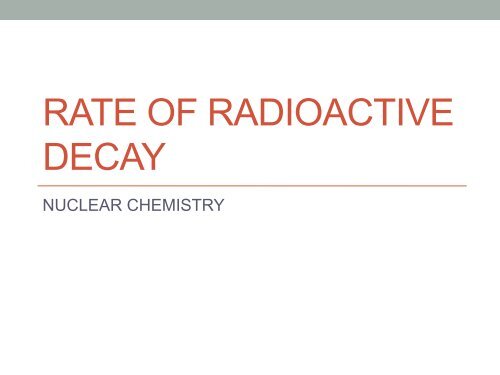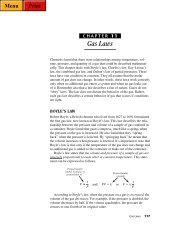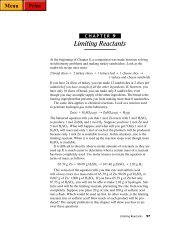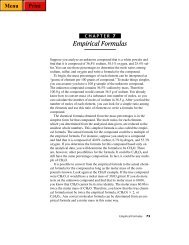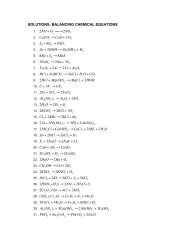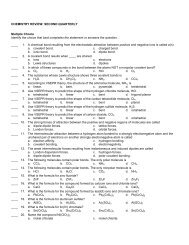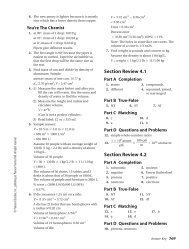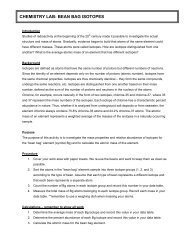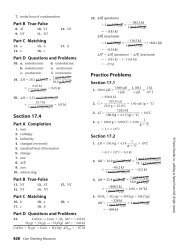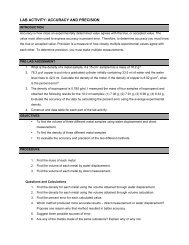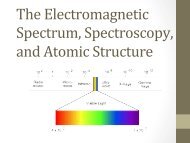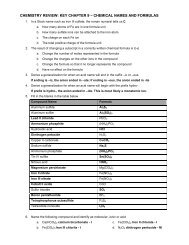Notes: Rate of Radioactive Decay
Notes: Rate of Radioactive Decay
Notes: Rate of Radioactive Decay
You also want an ePaper? Increase the reach of your titles
YUMPU automatically turns print PDFs into web optimized ePapers that Google loves.
RATE OF RADIOACTIVE<br />
DECAY<br />
NUCLEAR CHEMISTRY
GOALS<br />
• To understand the relationship between half-life, rate <strong>of</strong><br />
radioactivity and number <strong>of</strong> nuclei
REVIEW: RADIOACTIVE DECAY<br />
• When an unstable nucleus decays, it emits high energy<br />
particles or gamma radiation by a process called<br />
radioactive decay
REVIEW: RADIOACTIVE DECAY<br />
• Alpha decay<br />
• A nucleus ejects an alpha particle ( )<br />
• A new element is produced.<br />
• The daughter has a mass 4 less than the parent.<br />
• The daughter has an atomic number 2 less than the parent.<br />
• Example<br />
226 222 4<br />
88 Ra ! 86 Rn + 2 He<br />
4<br />
2 He
REVIEW: RADIOACTIVE DECAY<br />
• Beta <strong>Decay</strong><br />
• A nucleus ejects a beta particle ( )<br />
• A new element is produced<br />
• The daughter has the same mass as the parent<br />
• The daughter has an atomic number 1 more than the parent.<br />
• Example<br />
228 228 0<br />
88 Ra ! 89 Ac + "1e<br />
0<br />
!1e
REVIEW: RADIOACTIVE DECAY<br />
• Gamma <strong>Decay</strong><br />
• A high energy nucleus emits electromagnetic radiation in the form<br />
<strong>of</strong> gamma rays<br />
• Gamma rays have no mass and no charge<br />
• Example<br />
234 234 0<br />
90Th<br />
! 90Th<br />
+ 0!
RATE OF RADIOACTIVE DECAY<br />
• Each radioisotope decays at a different rate<br />
• This rate is called the half-life<br />
• It is unique and constant for each radioisotope.
HALF-LIFE<br />
• Half-life<br />
• The time needed for half <strong>of</strong> the radioactive atoms in a sample to<br />
decay to stable nuclei
LET’S COUNT!
HALF-LIFE
HALF-LIFE<br />
NO OF HALF-LIVES AMT OF PARENT<br />
REMAINING<br />
FRACTION OF PARENT<br />
REMAINING<br />
0 16 100% or 1 (16 ÷ 16)<br />
1 8 50% or ½ (8 ÷ 16)<br />
2 4 25% or ¼ (4 ÷ 16)<br />
3 2 12.5% or ⅛ (2 ÷ 16)
HALF-LIFE
HALF-LIFE
HALF-LIFE
HALF-LIFE<br />
• Can be found by measuring the rate <strong>of</strong> decay using a<br />
radiation detector
HALF-LIFE
HALF-LIFE<br />
• As parent decays to daughter, you have less unstable<br />
nuclei and more stable nuclei<br />
• The less stable the element, the higher the rate <strong>of</strong> radiation<br />
• The more radioactive the element, the shorter the half-life


